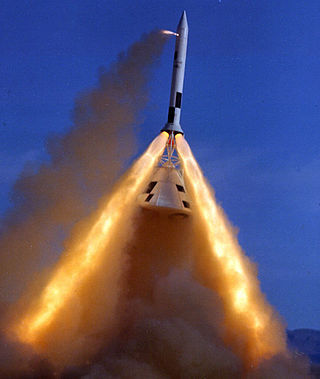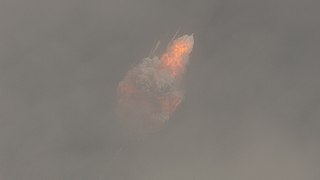
Human spaceflight is spaceflight with a crew or passengers aboard a spacecraft, often with the spacecraft being operated directly by the onboard human crew. Spacecraft can also be remotely operated from ground stations on Earth, or autonomously, without any direct human involvement. People trained for spaceflight are called astronauts, cosmonauts (Russian), or taikonauts (Chinese); and non-professionals are referred to as spaceflight participants or spacefarers.

A space capsule is a spacecraft designed to transport cargo, scientific experiments, and/or astronauts to and from space. Capsules are distinguished from other spacecraft by the ability to survive reentry and return a payload to the Earth's surface from orbit or sub-orbit, and are distinguished from other types of recoverable spacecraft by their blunt shape, not having wings and often containing little fuel other than what is necessary for a safe return. Capsule-based crewed spacecraft such as Soyuz or Orion are often supported by a service or adapter module, and sometimes augmented with an extra module for extended space operations. Capsules make up the majority of crewed spacecraft designs, although one crewed spaceplane, the Space Shuttle, has flown in orbit.

A launch escape system (LES) or launch abort system (LAS) is a crew-safety system connected to a space capsule. It is used in the event of a critical emergency to quickly separate the capsule from its launch vehicle in case of an emergency requiring the abort of the launch, such as an impending explosion. The LES is typically controlled by a combination of automatic rocket failure detection, and a manual activation for the crew commander's use. The LES may be used while the launch vehicle is still on the launch pad, or during its ascent. Such systems are usually of three types:

Satish Dhawan Space Centre – SDSC, is the primary spaceport of the Indian Space Research Organisation (ISRO), located in Sriharikota, Andhra Pradesh.

The Launch Vehicle Mark-3 or LVM3 is a three-stage medium-lift launch vehicle developed by the Indian Space Research Organisation (ISRO). Primarily designed to launch communication satellites into geostationary orbit, it is also due to launch crewed missions under the Indian Human Spaceflight Programme. LVM3 has a higher payload capacity than its predecessor, GSLV.

The Indian Human Spaceflight Programme is an ongoing programme by the Indian Space Research Organisation (ISRO) to develop the technology needed to launch crewed orbital spacecraft into low Earth orbit. Three uncrewed flights, named Gaganyaan-1, Gaganyaan-2 and Gaganyaan-3 are scheduled to launch in 2024, followed by crewed flight in 2024 on an HLVM3 rocket.
Human-rating certification, also known as man-rating or crew-rating, is the certification of a spacecraft or launch vehicle as capable of safely transporting humans. There is no one particular standard for human-rating a spacecraft or launch vehicle, and the various entities that launch or plan to launch such spacecraft specify requirements for their particular systems to be human-rated.
A pad abort test is a kind of test of a launch escape system which conducted by setting the system along with the spacecraft still on the ground and let the system activate to carry the spacecraft flying away, then separate in the air and make the spacecraft land safely. The purpose of the test is to determine how well the system could get the crew of a spacecraft to safety in an emergency on the launch pad. As the spacecraft is set still on the ground, the test is also called "zero-altitude abort test" in against "high-altitude abort test".

Gaganyaan is an Indian crewed orbital spacecraft intended to be the formative spacecraft of the Indian Human Spaceflight Programme. The spacecraft is being designed to carry three people, and a planned upgraded version will be equipped with rendezvous and docking capabilities. In its maiden crewed mission, the Indian Space Research Organisation (ISRO)'s largely autonomous 5.3-metric ton capsule will orbit the Earth at 400 km altitude for up to seven days with a two- or three-person crew on board. The first crewed mission was originally planned to be launched on ISRO's HLVM3 rocket in December 2021. As of October 2023, it is expected to be launched by 2025.

The Crew Module Atmospheric Re-entry Experiment (CARE) is an experimental test vehicle for the Indian Space Research Organisation's future ISRO orbital vehicle called Gaganyaan. It was launched successfully on 18 December 2014 from the Second Launch Pad of the Satish Dhawan Space Centre, by a LVM3 designated by ISRO as the LVM 3X CARE mission. Total cost of mission was ₹155 crore. Cost of launch vehicle and CARE module was ₹140 crore and ₹15 crore.

Ascent Abort-2 (AA-2) was a test of the launch escape system (LAS) of NASA's Orion spacecraft.

The Human Space Flight Centre (HSFC) is a body under the Indian Space Research Organisation (ISRO) to coordinate the Indian Human Spaceflight Programme. The agency will be responsible for implementation of the Gaganyaan project. The first crewed flight is planned for 2024 on a home-grown LVM3 rocket.
Indian Data Relay Satellite System or IDRSS is a planned Indian constellation of Inter-satellite communications satellites. It is planned to initially comprise two satellites, CMS-04 & IDRSS-2 in geostationary orbit. It will facilitate relay of information between various Indian spacecraft, in-flight launch vehicle monitoring and assist the Indian Human Spaceflight Programme.

Vyommitra is a female-looking spacefaring humanoid robot developed by the Indian Space Research Organisation to function on-board the Gaganyaan, a crewed orbital spacecraft. Vyommitra was first unveiled on 22 January 2020 at the Human Spaceflight and Exploration symposium in Bengaluru.

SpaceXCrew Dragon In-Flight Abort Test was a successful test of the SpaceX Dragon 2 abort system, conducted on 19 January 2020. It was the final assessment for the Crew Dragon capsule and Falcon 9 launch system before they would be certified to carry humans into space. Booster B1046.4 and an uncrewed capsule C205 were launched from Launch Complex 39A (LC-39A) on a suborbital trajectory, followed by an in-flight abort of the capsule at max Q and supersonic speed. The test was carried out successfully: the capsule pulled itself away from the booster after launch control commanded the abort, and landed safely.

The Crew Dragon Pad Abort Test was a spacecraft test conducted by SpaceX on 6 May 2015 from the Space Launch Complex 40 (SLC-40) at Cape Canaveral Air Force Station, Florida. As part of the development of NASA's Commercial Crew Program, the test demonstrated the spacecraft's abort system capability, verifying the capsule's eight side-mounted SuperDraco thrusters' capability to quickly power itself away from a failing rocket while it is still on the ground. It was one of the two tests conducted by SpaceX on the abort system of spacecraft, the other one being the Crew Dragon In-Flight Abort Test conducted on 19 January 2020.

Test Vehicle Abort Mission-1 (TV-D1) was a high altitude abort test performed as part of the Gaganyaan program, initially set to be held on 21 October 2023 at around 02:30 UTC. Liftoff was delayed to 03:15 UTC due to weather issues, and five seconds before launch it was put on hold by the on-board computer due to an engine anomaly, as reported in ISRO's mission livestream. The launch occurred at 04:30 UTC, and the crew module successfully separated from the launch vehicle. The crew module was successfully recovered by the Indian Navy. India is the fourth country, after Russia, the United States, and China, to successfully test this technology.
Gaganyaan-1 will be the first uncrewed test flight of the Gaganyaan programme, with launch planned for July 2024.

The Indian Orbital Space Station, officially called, Bharatiya Antariksha Station, is a planned modular space station to be constructed by India and operated by the Indian Space Research Organisation (ISRO). The space station would weigh 20 tonnes and maintain an orbit of approximately 400 kilometres above the Earth, where astronauts could stay for 15–20 days. Originally planned to be completed by 2030, it was later postponed to 2035 due to delays caused by technical issues related with the Gaganyaan crewed spaceflight mission and the COVID-19 pandemic in India. As of December 2023, the first module is expected to be launched in 2028 on an LVM3 launch vehicle, with the remaining modules to be launched by 2035 on the Next Generation Launch Vehicle.

Gaganyaan-4 will be the first crewed test flight of the Gaganyaan programme, with launch planned for 2025.
















